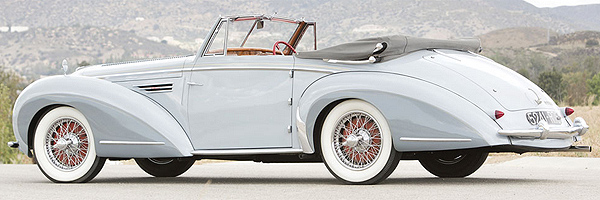Unusual Automotive Treasures
|
Sold for $412,500 on August 15, 2014 115 bhp, 3,557 cc OHV inline six-cylinder engine with single carburetor, Cotal electro-mechanical four-speed gearbox, independent front suspension with transverse leaf spring, live rear axle with quarter-elliptic springs, and four-wheel mechanical drum brakes. Wheelbase: 114 in. |
|
1951 Delahaye 135M Cabriolet |
|
|
The Delahaye’s 135, introduced in Paris in 1935, was a rare model that straddled both the pre-war and post-war era. It boasted a brand-new chassis with the same 3.6-liter, six-cylinder engine first seen in the earlier Type 138, and it proved to be a remarkable automobile upon its release. One year later, Delahaye introduced the 135M, which offered a slightly larger engine with improved horsepower and was offered with a choice of single, dual, or triple carburetors. The 135 proved to more than hold its own in competition, as it swept the top six places at Marseilles in 1936. In the following years, leading up to the beginning of the Second World War, the 135 further cemented its reputation, taking 2nd overall at Le Mans in 1937 and 1st, 2nd, and 4th the following year. Outside of Le Mans, Delahaye 135s also took 1st at the Rallye Monte Carlo in 1937 and 1939. Following the conclusion of the war, production of the Type 135 resumed and continued with the same 3.6-liter engine used before the war. By this time, the company was nearing its end, as the French government had placed large taxes on cars with displacement over three liters. Even today, six decades after the final Delahaye was produced, the famous 135 series cars remain very highly regarded as some of the most compelling French automobiles ever produced. This reputation is due as much to the fabulous custom coachwork with which the chassis were outfitted as it is to the fine engineering. Demanding clients requested fantastic designs for the sporting 135 from such coachbuilders as Figoni et Falaschi, Franay, Saoutchik, and, perhaps most prominently, Levallois-sur-Seine atelier Henry Chapron. |


